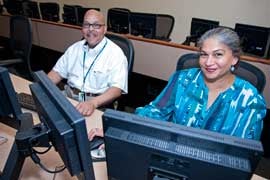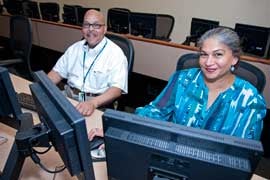 KINGSTON, R.I., – Aug. 7, 2013 – Student-managed equity funds are common on campuses but student-managed hedge funds, like the one operated by students taught by University of Rhode Island Professor of Finance and Decision Sciences Gordon Dash, are a rarity.
KINGSTON, R.I., – Aug. 7, 2013 – Student-managed equity funds are common on campuses but student-managed hedge funds, like the one operated by students taught by University of Rhode Island Professor of Finance and Decision Sciences Gordon Dash, are a rarity.
“This is not the old look at the paper and pick ‘em,” said Dash, who has been at URI for 39 years and had little interest in teaching traditional investing. “Quantitative modeling of financial securities is what I love to do.”
At one time, the international finance community was quicker than the United States to embrace the use of derivative securities to create a new type of portfolio known as a hedge fund. However, as interest in this country paralleled the global movement, the U.S. hedge fund industry surged to an estimated $2.13 trillion.*
Many people view hedge funds, which are private, not sold to the general public, as risky and aggressive. Dash, who has taught at the college level in Italy, South Africa, and India, said derivative securities have been a focus of worldwide investing and education for some time.
“For the better part of a decade, the increasing acceptance of quantitative finance has become a new way of delivering education globally and preparing students with an international focus,” Dash said. “Now savvy investors want to know more about how to use derivative instruments to mitigate investment risk.”
In Dash’s upper-level derivatives courses, students are immersed in hedge funds. They are building portfolios and writing reports based on strong technical analysis, aided by an automated trading system comprised of thousands of securities. URI Adjunct Associate Research Professor of Computer Science and Statistics Nina Kajiji created the artificial neural networks 12 years ago and she is continually improving them. Kajiji and Dash have been married for 23 years and the couple works together. Dash focuses on operations research methods and financial markets theory. In addition to developing mathematical performance statistics as required by current federal regulations, Kajiji makes sure the complex neural networks of the automated trading system mimic the brain to maximize returns and improve profitability while lowering volatility.
“You can expect it to perform better as time goes on. It will never be perfect but you want to win more than you lose,” Kajiji said.
In the URI Bruce S. Sherman Trading Room at the business college where stock tickers run continually, an image from Kajiji’s automated trading system flashes across a large screen for students to view and discuss.
“We network and map very effectively, with predicted behaviors replicating actual outcomes of chosen stocks while managing hundreds of portfolios,” Kajiji said.
Profits are posted in green and losses in red for 3,200 securities in the database. Kajiji’s software updates every 20 minutes and each trade costs less than four cents. The software generates reports and complies with existing and proposed federal regulations. Kajiji offers the software to URI at no expense. Approximately $7.3 million is managed by the automated trading platform. However, because of the experimental nature of the process, only three retail accounts are traded live, with actual dollars while the other portfolios trade with “paper” dollars. With annual returns more than double the average market return, both Dash and Kajiji hope it won’t be long before more real dollars are under the management of their College of Business students.
Business College Dean Mark Higgins had Dash and the former president of the College of Business Administration Financial Engineering Club present to the College’s Advisory Board last year about the hedge fund.
“The class helps extend the book knowledge that the students learn in their derivatives course by applying that knowledge by using Dr. Dash’s software to hedge a portfolio of stocks,” Higgins said. “The initial assignment is to hedge the Ram Fund. In doing so this allows the students to leverage the experience gained from the Ram Fund course. In the Ram Fund, students function as research analysts and manage an equity portfolio of real money. Last semester the fund earned an annual rate of 19 percent.”
For the students, who visit the New York Stock Exchange as part of the experience, the class is an opportunity to learn about hedge funds and understand how they work. Students put the experience gained on their resumes and use it as a talking point on job interviews.
“It’s the way of the future,” said Alexandra Cavleg, 22, of Coventry, R.I., who will graduate in December and wants to work at a venture capital firm. “We’re a team, not just a class.”
Having hedge fund experience in college can translate into a potential earning premium of $5,000 to $20,000 more a year, Dash said.
“We want the students who take the class to have more freedom to design risk-mitigating investment portfolios,” Dash said. “We are taking the traditional approach and enhancing it, adding options and futures to the overall portfolio mix. It’s an exciting time to bring that life into the classroom.”
Dash and Kajiji, who live in Providence, hope hedge funds will eventually be used to improve the local economy. Dash is constantly thinking about the problems that struggling Rhode Island municipalities are experiencing as they are unable to fulfill pension obligations. He believes that having even a small portion of those pensions invested in a hedge fund could produce better returns, especially during tough economic times.
“If we used a different set of techniques to avoid losses we would put ourselves in a much better position,” said Dash, who noted that only very recently, pension funds in the state have been diversified to include a significant presence in hedge funds. “This is a good strategy that should help to offset unwanted declines in value, and thus, have an impact for the greater good of society.”
*Chung, Juliet (19 April 2012). “Hedge-Fund Assets Rise to Record Level”. The Wall Street Journal.
Pictured above
In the Bruce S. Sherman Trading Room at URI’s College of Business Administration are Professor of Finance and Decision Sciences Gordon Dash and Adjunct Associate Research Professor of Computer Science and Statistics Nina Kajiji. Dash and Kajiji created a hedge fund managed by undergraduate business students that they hope will eventually help struggling Rhode Island municipalities.
Communications & Marketing photo by Michael Salerno Photography.

